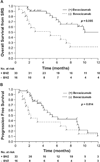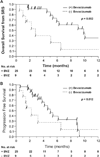Safety and efficacy of stereotactic radiosurgery and adjuvant bevacizumab in patients with recurrent malignant gliomas
- PMID: 21489708
- PMCID: PMC3690566
- DOI: 10.1016/j.ijrobp.2010.12.074
Safety and efficacy of stereotactic radiosurgery and adjuvant bevacizumab in patients with recurrent malignant gliomas
Abstract
Purpose: Patients with recurrent malignant gliomas treated with stereotactic radiosurgery (SRS) and multiagent systemic therapies were reviewed to determine the effects of patient- and treatment-related factors on survival and toxicity.
Methods and materials: A retrospective analysis was performed on patients with recurrent malignant gliomas treated with salvage SRS from September 2002 to March 2010. All patients had experienced progression after treatment with temozolomide and radiotherapy. Salvage SRS was typically administered only after multiple postchemoradiation salvage systemic therapies had failed.
Results: 63 patients were treated with SRS for recurrent high-grade glioma; 49 patients had World Health Organization (WHO) Grade 4 disease. Median follow-up was 31 months from primary diagnosis and 7 months from SRS. Median overall survival from primary diagnosis was 41 months for all patients. Median progression-free survival (PFS) and overall survival from SRS (OS-SRS) were 6 and 10 months for all patients, respectively. The 1-year OS-SRS for patients with Grade 4 glioma who received adjuvant (concurrent with or after SRS) bevacizumab was 50% vs. 22% for patients not receiving adjuvant bevacizumab (p = 0.005). Median PFS for patients with a WHO Grade 4 glioma who received adjuvant bevacizumab was 5.2 months vs. 2.1 months for patients who did not receive adjuvant bevacizumab (p = 0.014). Karnofsky performance status (KPS) and age were not significantly different between treatment groups. Treatment-related Grade 3/4 toxicity for patients receiving and not receiving adjuvant BVZ was 10% and 14%, respectively (p = 0.58).On multivariate analysis, the relative risk of death and progression with adjuvant bevacizumab was 0.37 (confidence interval [CI] 0.17-0.82) and 0.45 (CI 0.21-0.97). KPS >70 and age <50 years were significantly associated with improved survival.
Conclusions: The combination of salvage radiosurgery and bevacizumab to treat recurrent malignant gliomas is well tolerated and seems to be associated with improved outcomes. Prospective multiinstitutional studies are required to determine efficacy and long-term toxicity with this approach.
Copyright © 2012 Elsevier Inc. All rights reserved.
Conflict of interest statement
Conflict of interest: none.
Figures



Similar articles
-
Concurrent stereotactic radiosurgery and bevacizumab in recurrent malignant gliomas: a prospective trial.Int J Radiat Oncol Biol Phys. 2013 Aug 1;86(5):873-9. doi: 10.1016/j.ijrobp.2013.04.029. Epub 2013 May 29. Int J Radiat Oncol Biol Phys. 2013. PMID: 23725997
-
Irradiation and bevacizumab in high-grade glioma retreatment settings.Int J Radiat Oncol Biol Phys. 2012 Jan 1;82(1):67-76. doi: 10.1016/j.ijrobp.2010.09.002. Epub 2010 Oct 27. Int J Radiat Oncol Biol Phys. 2012. PMID: 21030162
-
Role of adjuvant or salvage radiosurgery in the management of unresected residual or progressive glioblastoma multiforme in the pre-bevacizumab era.J Neurosurg. 2015 Apr;122(4):757-65. doi: 10.3171/2014.11.JNS13295. Epub 2015 Jan 16. J Neurosurg. 2015. PMID: 25594327
-
Anti-angiogenic therapy for high-grade glioma.Cochrane Database Syst Rev. 2018 Nov 22;11(11):CD008218. doi: 10.1002/14651858.CD008218.pub4. Cochrane Database Syst Rev. 2018. PMID: 30480778 Free PMC article.
-
Recurrent malignant gliomas.Semin Radiat Oncol. 2014 Oct;24(4):289-98. doi: 10.1016/j.semradonc.2014.06.006. Semin Radiat Oncol. 2014. PMID: 25219814 Free PMC article. Review.
Cited by
-
Fractionated stereotactic radiotherapy plus bevacizumab after response to bevacizumab plus irinotecan as a rescue treatment for high-grade gliomas.Rep Pract Oncol Radiother. 2015 May-Jun;20(3):231-8. doi: 10.1016/j.rpor.2015.01.004. Epub 2015 Feb 20. Rep Pract Oncol Radiother. 2015. PMID: 25949228 Free PMC article.
-
Assessment of therapeutic outcome and role of reirradiation in patients with radiation-induced glioma.Radiat Oncol. 2022 May 3;17(1):85. doi: 10.1186/s13014-022-02054-x. Radiat Oncol. 2022. PMID: 35505351 Free PMC article.
-
Salvage fractionated stereotactic re-irradiation (FSRT) for patients with recurrent high grade gliomas progressed after bevacizumab treatment.J Neurooncol. 2018 Mar;137(1):171-177. doi: 10.1007/s11060-017-2709-0. Epub 2017 Dec 12. J Neurooncol. 2018. PMID: 29235052
-
Treatment mechanism and research progress of bevacizumab for glioblastoma.Am J Cancer Res. 2025 Apr 25;15(4):1874-1901. doi: 10.62347/RNUE7193. eCollection 2025. Am J Cancer Res. 2025. PMID: 40371151 Free PMC article. Review.
-
Recent advancements in multimodality treatment of gliomas.Future Oncol. 2011 Oct;7(10):1169-83. doi: 10.2217/fon.11.102. Future Oncol. 2011. PMID: 21992729 Free PMC article. Review.
References
-
- Stupp R, Hegi ME, Mason WP, et al. Effects of radiotherapy and adjuvant temozolomide versus radiotherapy alone on survival in glioblastoma in a randomised phase III study, 5-year analysis of the EORTC-NCIC trial. Lancet Oncol. 2009;10:459–466. - PubMed
-
- Sneed PK, Gutin PH, Larson DA, et al. Patterns of recurrence of glioblastoma multiforme after external irradiation followed by implant boost. Int J Radiat Oncol Biol Phys. 1994;29:719–727. - PubMed
-
- Combs SE, Gutwein S, Thilmann C, et al. Stereotactically guided fractionated re-irradiation in recurrent glioblastoma multiforme. J Neurooncol. 2005;74:167–171. - PubMed
-
- Combs SE,Widmer V, Thilmann C, et al. Stereotactic radiosurgery: Treatment option for recurrent glioblastoma multiforme. Cancer. 2005;104:2168–2173. - PubMed
-
- Dirks P, Bernstein M, Muller PJ, et al. The value of reoperation for recurrent glioblastoma. Can J Surg. 1993;36:271–275. - PubMed
MeSH terms
Substances
Grants and funding
LinkOut - more resources
Full Text Sources
Medical

